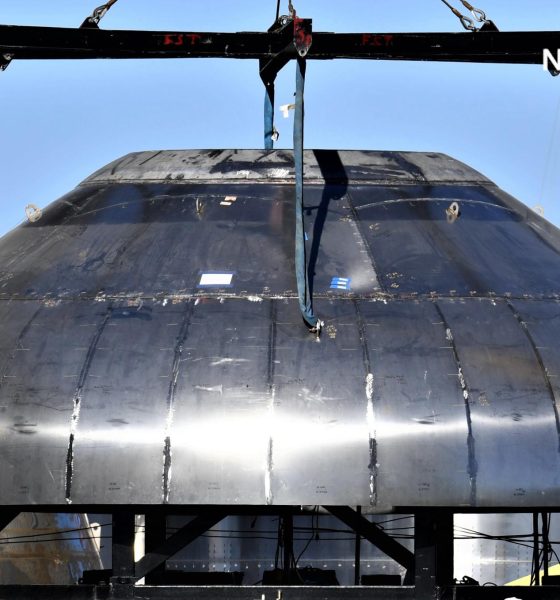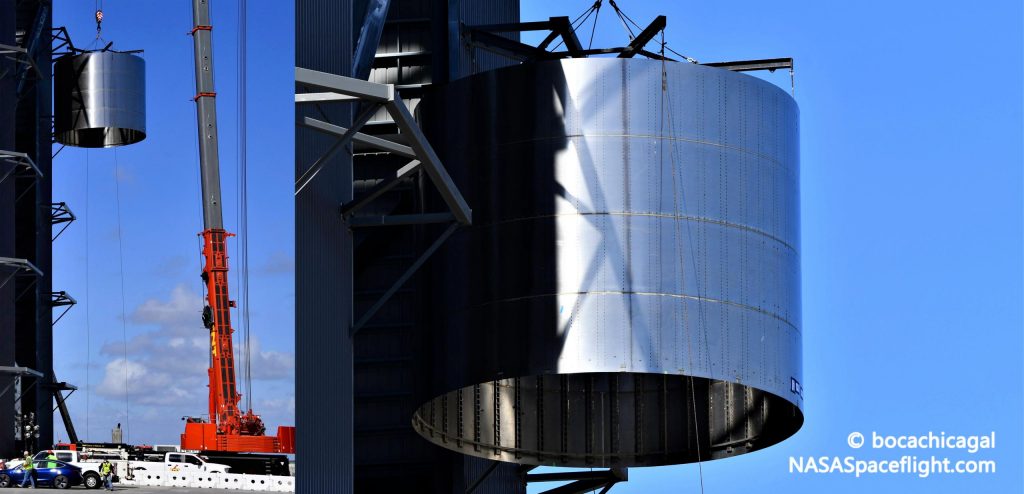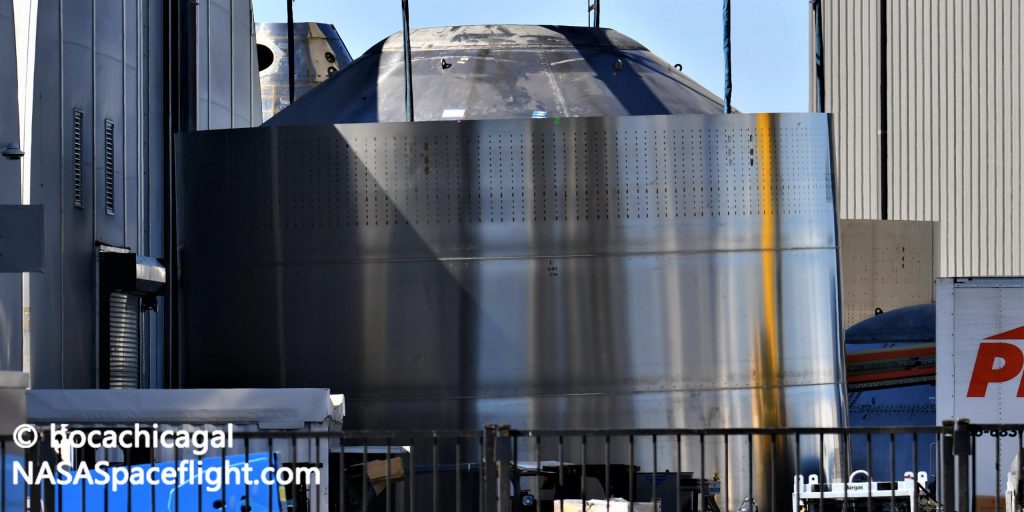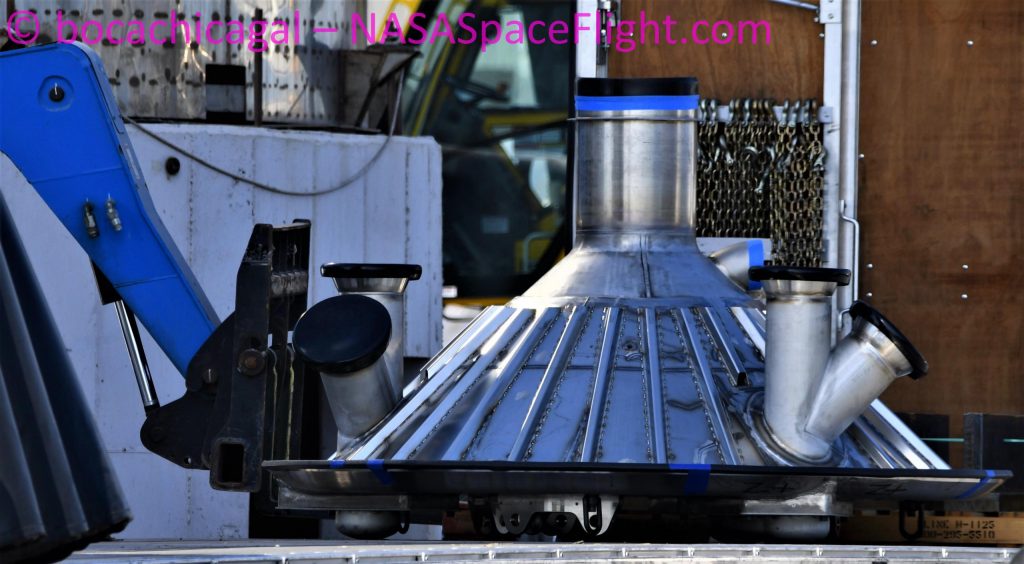

News
SpaceX’s first Starship booster a step closer as custom parts arrive
While SpaceX remains focused on Starship flight testing as the dust settles from SN8’s launch debut, the company continues to make slow but steady progress building the first Super Heavy booster prototype.
For the most part, SpaceX has learned from trial and error and developed a decent stainless steel rocket manufacturing process by building a dozen Starship prototypes over the last ~12 months, ranging from a lone nosecone tip to stout test tanks and Starship SN8, which launched to 12.5 km (~7.8 mi) earlier this month. Practically identical below the nose, Super Heavy directly benefits from that maturity and is more or less an extended Starship tank section with more engines and bigger legs.
In many ways, Super Heavy can be much simpler than Starship, as a suborbital booster has no need for header tanks, flaps, or a nosecone, and can be much stronger and heavier in all aspects. However, carrying three or more times as propellant as Starship (and carrying Starship itself), Super Heavy also needs to be stronger. All those changes – requiring new design work and new fabrication – take time. In a great sign that most of that work is complete, some of that custom hardware needed to strengthen and power Super Heavy has begun to arrive over the last several weeks.

SpaceX began stacking the first Super Heavy booster (BN1) on November 8th and appears to have more or less paused integration operations after joining eight rings. Production continued apace, however, and no less than five ring sections destined for Super Heavy appeared over the next several weeks. Why assembly slowed down is unclear but it’s reasonable to assume that SpaceX was trying to keep its focus primarily on Starship SN8’s launch debut and the preparation of several other full-scale ships, where early work on Super Heavy could ultimately be for naught if Starship flight tests uncover major design flaws.
Regardless of the reason, BN1 remains eight rings (14.5m/48ft) tall as of December 14th, representing one-fifth of Super Heavy’s full 70-meter (~230 ft) height.

On December 17th, one of the parts unique to Super Heavy unexpectedly appeared in SpaceX’s South Texas shipyard, labeled “B1 FWD PIPE DOME”. The dome was quickly sleeved with a stack of three steel rings with labels confirming that the assembly was Super Heavy BN1’s common tank dome – “common” because it’s shared by both booster propellant tanks. The new dome is unique to all previous Starship domes, featuring a smaller, more reinforced cutout – likely because Super Heavy doesn’t need header tanks.
It also appears to borrow from Starship’s forward dome design, using the same rougher steel normally used to cap off Starship methane tanks.


Unlike Starship common domes, which place a spherical methane header tank at the bottom, Super Heavy’s common dome will have a transfer tube welded directly to its nozzle-like opening. As it turns out, what could be the first Super Heavy methane transfer tube was delivered to Boca Chica late last month.
Unlike Starship transfer tubes, the new plumbing appeared to have a much wider diameter and was delivered in four sections, meshing well with the fact that Super Heavy tanks are roughly twice as tall as Starship’s. Able to support as many as 28 Raptors compared to Starship’s 6, Super Heavy transfer tubes will also need to pump more than five times as much methane per second at full thrust, which could explain the larger diameter.


Finally and perhaps most significantly, aerial photos from RGV Photography appeared to capture the first glimpse of what might be the hardest custom part required by Super Heavy – a thrust structure designed to support up to 28 Raptor engines. On December 10th, casually sitting between Starship Mk1’s remains (on the white concrete mount) and a tent, a flat ring with clear eightfold symmetry and a donut-like cutout large enough to fit a Starship thrust puck with room to spare was easily visible.
The hexagonal symmetry was the main giveaway, matching comments from CEO Elon Musk that Super Heavy’s thrust structure will feature a central ring of eight engines surrounded by an outer ring of up to 20 more Raptors. Assuming the first Super Heavy booster only flies with a few Raptor engines, that sole eight-engine ‘puck’ may be all that SpaceX needs to complete BN1.


Elon Musk
Elon Musk’s X will start using a Tesla-like software update strategy
The initiative seems designed to accelerate updates to the social media platform, while maintaining maximum transparency.

Elon Musk’s social media platform X will adopt a Tesla-esque approach to software updates for its algorithm.
The initiative seems designed to accelerate updates to the social media platform, while maintaining maximum transparency.
X’s updates to its updates
As per Musk in a post on X, the social media company will be making a new algorithm to determine what organic and advertising posts are recommended to users. These updates would then be repeated every four weeks.
“We will make the new 𝕏 algorithm, including all code used to determine what organic and advertising posts are recommended to users, open source in 7 days. This will be repeated every 4 weeks, with comprehensive developer notes, to help you understand what changed,” Musk wrote in his post.
The initiative somewhat mirrors Tesla’s over-the-air update model, where vehicle software is regularly refined and pushed to users with detailed release notes. This should allow users to better understand the details of X’s every update and foster a healthy feedback loop for the social media platform.
xAI and X
X, formerly Twitter, has been acquired by Elon Musk’s artificial intelligence startup, xAI last year. Since then, xAI has seen a rapid rise in valuation. Following the company’s the company’s upsized $20 billion Series E funding round, estimates now suggest that xAI is worth tens about $230 to $235 billion. That’s several times larger than Tesla when Elon Musk received his controversial 2018 CEO Performance Award.
As per xAI, the Series E funding round attracted a diverse group of investors, including Valor Equity Partners, Stepstone Group, Fidelity Management & Research Company, Qatar Investment Authority, MGX, and Baron Capital Group, among others. Strategic partners NVIDIA and Cisco Investments also continued support for building the world’s largest GPU clusters.
News
Tesla FSD Supervised wins MotorTrend’s Best Driver Assistance Award
The decision marks a notable reversal for the publication from prior years, with judges citing major real-world improvements that pushed Tesla’s latest FSD software ahead of every competing ADAS system.

Tesla’s Full Self-Driving (Supervised) system has been named the best driver-assistance technology on the market, earning top honors at the 2026 MotorTrend Best Tech Awards.
The decision marks a notable reversal for the publication from prior years, with judges citing major real-world improvements that pushed Tesla’s latest FSD software ahead of every competing ADAS system. And it wasn’t even close.
MotorTrend reverses course
MotorTrend awarded Tesla FSD (Supervised) its 2026 Best Tech Driver Assistance title after extensive testing of the latest v14 software. The publication acknowledged that it had previously criticized earlier versions of FSD for erratic behavior and near-miss incidents, ultimately favoring rivals such as GM’s Super Cruise in earlier evaluations.
According to MotorTrend, the newest iteration of FSD resolved many of those shortcomings. Testers said v14 showed far smoother behavior in complex urban scenarios, including unprotected left turns, traffic circles, emergency vehicles, and dense city streets. While the system still requires constant driver supervision, judges concluded that no other advanced driver-assistance system currently matches its breadth of capability.
Unlike rival systems that rely on combinations of cameras, radar, lidar, and mapped highways, Tesla’s FSD operates using a camera-only approach and is capable of driving on city streets, rural roads, and freeways. MotorTrend stated that pure utility, the ability to handle nearly all road types, ultimately separated FSD from competitors like Ford BlueCruise, GM Super Cruise, and BMW’s Highway Assistant.
High cost and high capability
MotorTrend also addressed FSD’s pricing, which remains significantly higher than rival systems. Tesla currently charges $8,000 for a one-time purchase or $99 per month for a subscription, compared with far lower upfront and subscription costs from other automakers. The publication noted that the premium is justified given FSD’s unmatched scope and continuous software evolution.
Safety remained a central focus of the evaluation. While testers reported collision-free operation over thousands of miles, they noted ongoing concerns around FSD’s configurable driving modes, including options that allow aggressive driving and speeds beyond posted limits. MotorTrend emphasized that, like all Level 2 systems, FSD still depends on a fully attentive human driver at all times.
Despite those caveats, the publication concluded that Tesla’s rapid software progress fundamentally reshaped the competitive landscape. For drivers seeking the most capable hands-on driver-assistance system available today, MotorTrend concluded Tesla FSD (Supervised) now stands alone at the top.
News
Elon Musk’s Grokipedia surges to 5.6M articles, almost 79% of English Wikipedia
The explosive growth marks a major milestone for the AI-powered online encyclopedia, which was launched by Elon Musk’s xAI just months ago.

Elon Musk’s Grokipedia has grown to an impressive 5,615,201 articles as of today, closing in on 79% of the English Wikipedia’s current total of 7,119,376 articles.
The explosive growth marks a major milestone for the AI-powered online encyclopedia, which was launched by Elon Musk’s xAI just months ago. Needless to say, it would only be a matter of time before Grokipedia exceeds English Wikipedia in sheer volume.
Grokipedia’s rapid growth
xAI’s vision for Grokipedia emphasizes neutrality, while Grok’s reasoning capabilities allow for fast drafting and fact-checking. When Elon Musk announced the initiative in late September 2025, he noted that Grokipedia would be an improvement to Wikipedia because it would be designed to avoid bias.
At the time, Musk noted that Grokipedia “is a necessary step towards the xAI goal of understanding the Universe.”
Grokipedia was launched in late October, and while xAI was careful to list it only as Version 0.1 at the time, the online encyclopedia immediately earned praise. Wikipedia co-founder Larry Sanger highlighted the project’s innovative approach, noting how it leverages AI to fill knowledge gaps and enable rapid updates. Netizens also observed how Grokipedia tends to present articles in a more objective manner compared to Wikipedia, which is edited by humans.
Elon Musk’s ambitious plans
With 5,615,201 total articles, Grokipedia has now grown to almost 79% of English Wikipedia’s article base. This is incredibly quick, though Grokipedia remains text-only for now. xAI, for its part, has now updated the online encyclopedia’s iteration to v0.2.
Elon Musk has shared bold ideas for Grokipedia, including sending a record of the entire knowledge base to space as part of xAI’s mission to preserve and expand human understanding. At some point, Musk stated that Grokipedia will be renamed to Encyclopedia Galactica, and it will be sent to the cosmos.
“When Grokipedia is good enough (long way to go), we will change the name to Encyclopedia Galactica. It will be an open source distillation of all knowledge, including audio, images and video. Join xAI to help build the sci-fi version of the Library of Alexandria!” Musk wrote, adding in a later post that “Copies will be etched in stone and sent to the Moon, Mars and beyond. This time, it will not be lost.”








